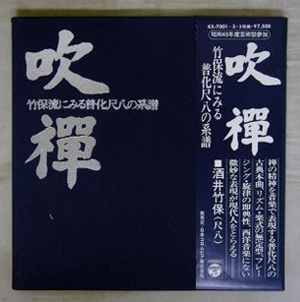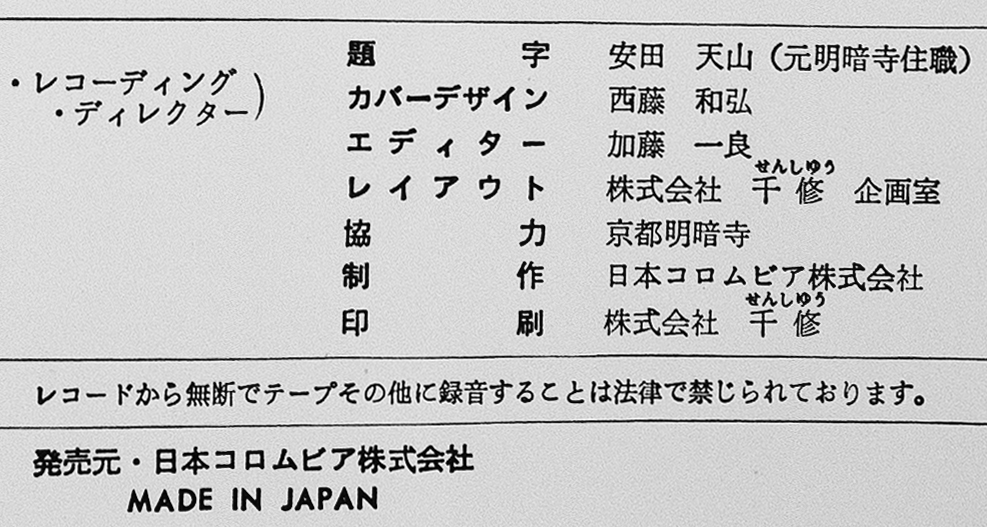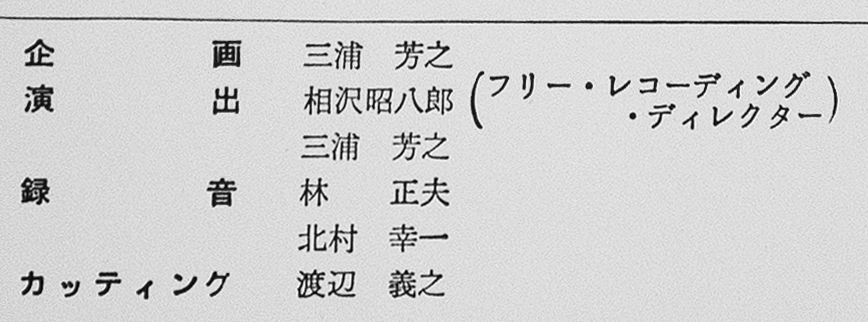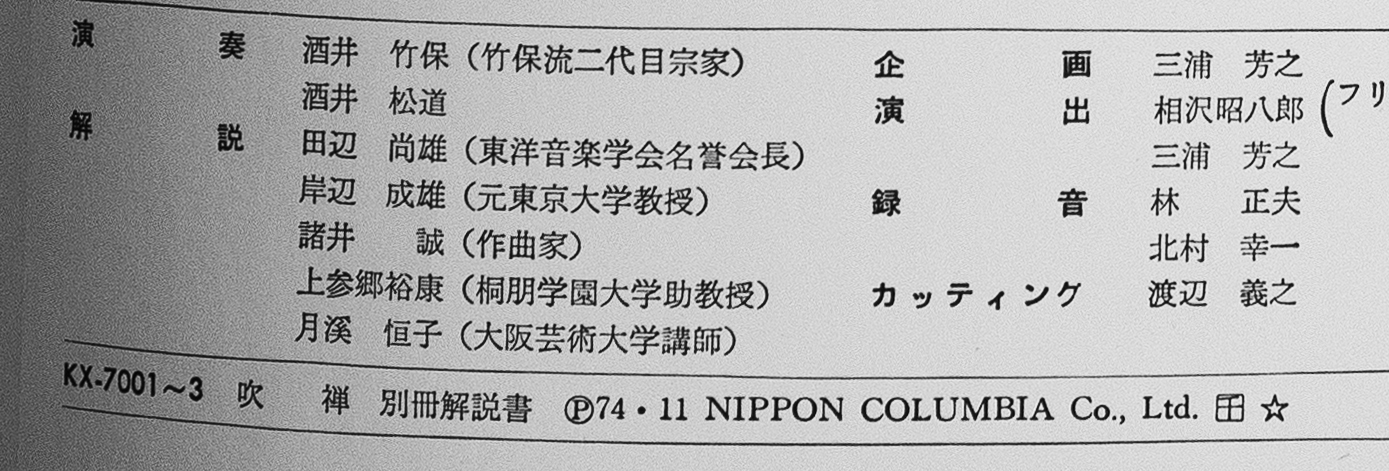|
1974: The Nippon Columbia 'Suizen' Triple-LP Set with
a "Separate Commentary Book" by Kamisangō Yūkō and others.
Why Did the Nippon Columbia Record Company
Ever Put Out That 1974 LP Album 'Suizen'?


Present web page first established and presented online on Saturday October 26, 2024.
To be further elaborated with more details, as time goes by.
A Historic Nippon Columbia triple-vinyl set, phonogram numbers: KX-7001~3.
Music tracks recorded on July 4 through 6, 1974.
Finally released in Japan in November, 1974.
Full title of that historic vinyl record collection:
'Suizen. Chikuhō-ryū ni miru Fuke Shakuhachi no keifu',
竹保流に見る普化尺八の系譜,
"Suizen. The Lineage of Fuke Shakuhachi as Observed in the Chikuhō Tradition."
Chikuhō shakuhachi pieces performed by Sakai Chikuhō II, assisted by Sakai Shodō on two tracks on LP 3, side 2.
Cover front title lettering/calligraphy by Yasuda Tenzan,
安田天山,
first true Myōan Temple chief monk from 1950 through 1953.
Liner notes, 48 pages, by Kamisangō Yūkō and others, plus transcribed shakuhachi music
in Western staff notation.
Full title of the liner notes article officially authored by Kamisangō Yūkō,
though reportedly assisted by four supplementary "explainers" in other chapters:
This is the title of Kamisangō Yūkō's article in the accompanying pamphlet:
'Shakuhachi gaku ryakushi: Suizen no rikai no tame ni',
尺八楽略史: 吹禅の理解のために,
"Short History of Shakuhachi Music. Towards an Understanding of 'Suizen'".
Selected parts of that article were adapted and published in English translation by Christopher Yohmei Blasdel first in 1988 in his book
"The Shakuhachi. A Manual of Learning." Republished in 2008.
According to the notes on page 44 produced in some possible degree of cooperation with the Kyōto Myōan Temple that first defined and introduced the term 'Suizen' in 1950.
The Myōan Temple 'Kansu' in 1974, head of the temple's then Taizan-ha Shakuhachi Department, was Fukumoto Kyoan
who was in office from 1972 till his death in 1976.
Now, the important question here is:
Who were those people in Japan, within and around the Nippon Columbia record company, way back then:
writing now exactly five decades ago, in 1974, who stood behind that 1974 'Suizen' vinyl LP record production?
Who got that pretty bad idea to put out in public such a quite historically misleading "shakuhachi music product"?
What was their purpose, their intention, their agenda?
Well, when you do more carefully study the credit notes, printed on page 44 in the liner note pamphlet that accompanies the three LPs,
you get some better understanding of the "set up", the involved "line up" of participants:
Those "complicit" in the strange scheme to somehow "commercialize" and "popularize" the concept of original Kyōto Myōan Temple 'Suizen',
that was first introduced only in 1950, a quarter of a century previously - who were they?
How come that Myōan-ji apparently somehow assisted Nippon Columbia in producing their 1974 'Suizen' manifesto that did not at all represent
the Taizan-ha way of playing, that had already been prominently preserved by Tanikita Muchiku, allegedly between 1953 and 1956?
Could it be just a coincidence that soon after 1974, when in 1976 Yoshimura Fuan Sōshin had been appointed 40th 'Kansu' after Fukumoto Kyoan
recorded the complete repertory of Taizan-ha 'kyoku' that were, eventually, released also on three CDs in 1995, under the title
'Suizen ichinyo', 吹禅一如 ?
Acknowledgement:
I am very grateful to Ronald Nelson, former president of the International Shakuhachi Society/ISS,
for providing me with a complete set of photographs of all the pages in the 1974 Nippon Columbia KX 7001-3 pamphlet, back in 2014,
without which the present study would never have been possible.

The sound quality technicalities:
Recorded on July 4th through 6th, 1974
4-channel "P.C.M." recorder
Microphones: Vintage Neumann M-49C, MKH-405, MD211U
Vinyl cutter: Neumann SX-74

In this part of the credit notes on page 44, top, you see that Yasuda Tenzan supplied
the ‘Suizen’ title calligraphy for the cover front design.
Beside a named cover designer, an editor, and a layout’er, you are also informed there
that a cooperating actor was that of: The Kyōto Myōan Temple!
How so, possibly, tell us ... ?

Here, planning, sound producers and sound engineers are specifically credited by names.

First, the names of the two shakuhachi players performing in the recordings are listed, namely:
Sakai Chikuhō II, and Sakai Shodō.
Next, follow the names of the five contributors, "explainers", authors, to the liner notes chapters:
Tanabe Hisao, musicologist, 1883-1984 -
Kishibe Shigeo, musicologist, 1912-2005 -
Moroi Makoto, composer, 1930-2013 -
Kamisangō Yūkō, musicologist, 1935-2018 -
Tsukitani Tsuneko, musicologist, 1944-2010 -

Page 44 with complete credit notes presented in the above.
Link to some music samples and pictures:
Silencia Music Store: 1974 Nippon Columbia 'Suizen' LPs, track list, pictures
ISS/Komuso.com: History
Read more here:
1974: 'Komusō' & 'Suizen'?: The Emperor's New Clothes!
PART 1
What Prof. Kamisangō Yūkō Once Precisely Told Us
about Supposed "Edo Period 'Komusō Suizen' Life"
|
|







